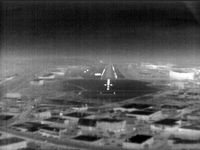Thu, Jul 21, 2005
Rockwell Collins Completes Successful SE-Vision Test
Flights
 Rockwell Collins' SE-Vision program
has reached a new milestone by successfully completing military and
commercial test flights in New Mexico and New Jersey in June.
SE-Vision flight deck technology, which integrates synthetic vision
generated scenes with real-time enhanced vision imagery, is being
developed by Rockwell Collins in collaboration with the Federal
Aviation Administration (FAA), the Air Force Research Lab (AFRL),
NASA Langley Research Center and Max-Viz.
Rockwell Collins' SE-Vision program
has reached a new milestone by successfully completing military and
commercial test flights in New Mexico and New Jersey in June.
SE-Vision flight deck technology, which integrates synthetic vision
generated scenes with real-time enhanced vision imagery, is being
developed by Rockwell Collins in collaboration with the Federal
Aviation Administration (FAA), the Air Force Research Lab (AFRL),
NASA Langley Research Center and Max-Viz.
 The SE-Vision program flight tests
demonstrated concepts for sensor and synthetic imagery for use by
the US Air Force's mobility operations in a low altitude tactical
environment. The flights were conducted through June on the FAA
William J. Hughes Technical Center's Boeing 727-100 which was
equipped with Rockwell Collins HGS-4000 Heads-Up Guidance System
(HGSTM), Max-Viz Dual Band Infrared Sensors, Rockwell Collins
MultiScan Hazard Weather Detection System and an LCD head-down
display (HDD). SE-Vision display and guidance concepts were shown
on both the HUD and the HDD.
The SE-Vision program flight tests
demonstrated concepts for sensor and synthetic imagery for use by
the US Air Force's mobility operations in a low altitude tactical
environment. The flights were conducted through June on the FAA
William J. Hughes Technical Center's Boeing 727-100 which was
equipped with Rockwell Collins HGS-4000 Heads-Up Guidance System
(HGSTM), Max-Viz Dual Band Infrared Sensors, Rockwell Collins
MultiScan Hazard Weather Detection System and an LCD head-down
display (HDD). SE-Vision display and guidance concepts were shown
on both the HUD and the HDD.
"SE-Vision provides a visualization solution for pilots who are
required to fly in low visibility conditions and unfamiliar
territory," said Tim Etherington, principal systems engineer at
Rockwell Collins Advanced Technology Center. "This technology can
have a major impact on the success of special operations missions
in the military, and provide promising opportunities for civil
aviation as well."
"The combination of synthetic vision and sensor technologies
will allow USAF mobility operations to operate independently of
visibility with improved situation awareness and safety," said Guy
French, SE-Vision Government Program Manager, AFRL.
 The demonstration flights took place
on a practice route used by Kirtland Air Force Base in New Mexico
for low level training. The routes used SE-Vision technology to
guide the aircraft through a mountain range at a pilot selected
altitude of 650 feet above the terrain for this flight test. Ten
Air Force pilots flew the terrain following path using SE-Vision
technology. A simulated version of the terrain following route was
demonstrated out of the William J. Hughes Technical Center in
Atlantic City, NJ.
The demonstration flights took place
on a practice route used by Kirtland Air Force Base in New Mexico
for low level training. The routes used SE-Vision technology to
guide the aircraft through a mountain range at a pilot selected
altitude of 650 feet above the terrain for this flight test. Ten
Air Force pilots flew the terrain following path using SE-Vision
technology. A simulated version of the terrain following route was
demonstrated out of the William J. Hughes Technical Center in
Atlantic City, NJ.
More News
LinxUs System Adds Capabilities for Data-Driven Operators Textron Aviation announced another option for operators processing their post-flight data, adding interoperability with GE>[...]
Aero Linx: The de Havilland Moth Club Ltd The de Havilland Moth Club evolved from a belief that an association of owners and operators of Moth aeroplanes should be formed to create>[...]
(Pilot) Inadvertently Applied Excessive Braking Action, And The Airplane Nosed Over Analysis: The pilot reported that, while landing at a remote, rough and uneven airstrip in a tai>[...]
“MCADT is committed to rapidly integrating armed first-person view drones into the FMF, enhancing small-unit lethality and providing organic capabilities that warfighters cur>[...]
From 2017 (YouTube Edition): Major Engine Supplier Joins Forces With Small Aircraft Manufacturer… GE recently made an agreement with Venom Aircraft to supply engines for the>[...]
 Citation Operators Get Another Flight Data Connection for QA
Citation Operators Get Another Flight Data Connection for QA ANN's Daily Aero-Linx (06.01.25)
ANN's Daily Aero-Linx (06.01.25) NTSB Final Report: Bellanca 8GCBC
NTSB Final Report: Bellanca 8GCBC Aero-News: Quote of the Day (06.01.25)
Aero-News: Quote of the Day (06.01.25) Classic Aero-TV: High-Speed Match-up - Venom and GE Rebirth A Legend
Classic Aero-TV: High-Speed Match-up - Venom and GE Rebirth A Legend





